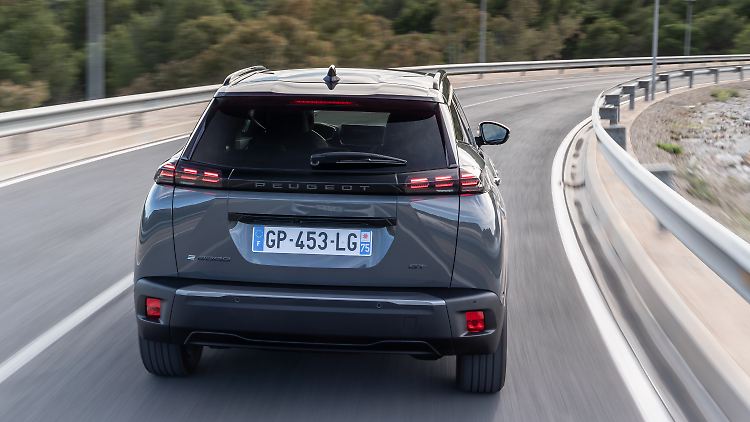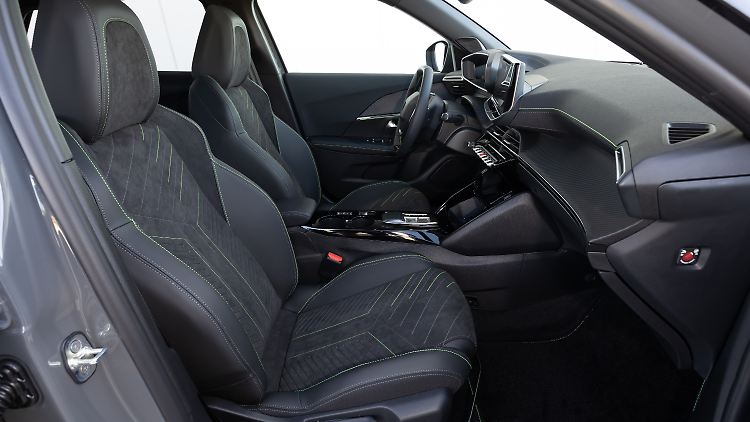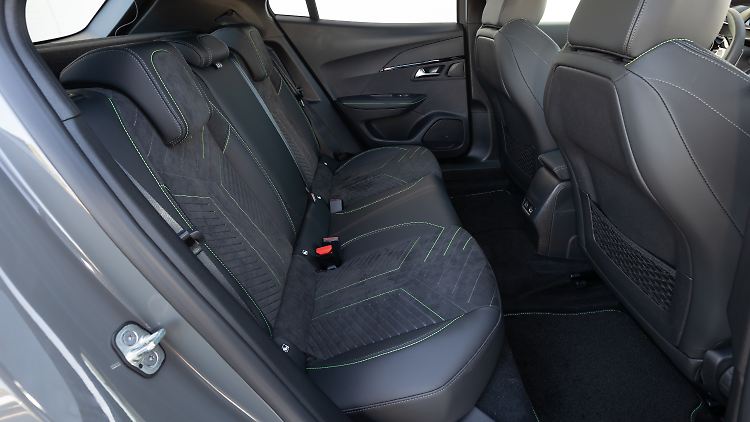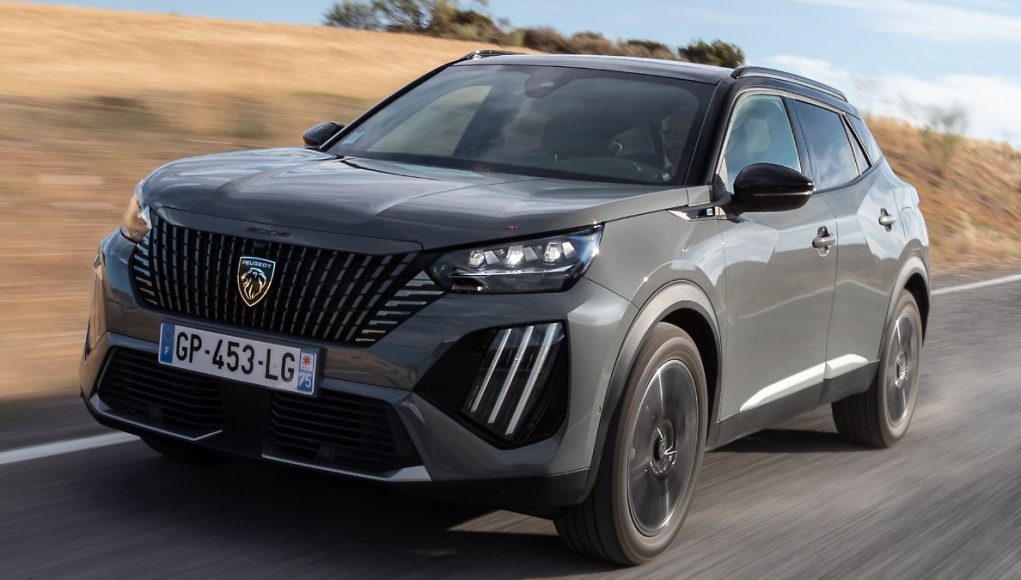Good little lion in the test
Peugeot e-2008 – now more range, but not a long-distance vehicle
This audio version was artificially generated. More info | Send feedback
Larger battery, lower consumption: The small electric SUV Peugeot e-2008 has come further since the facelift. However, it still doesn’t have its advantages over long distances.
The electric SUV e-2008, introduced by Peugeot at the end of 2019, received a larger battery and a more powerful and more efficient electric motor along with a facelift last year. While the Frenchman can be more pleasing to the eye than before with optical innovations inside and out, the drive upgrade ensures more momentum and endurance. Despite the additional kilowatt hours, the little lion does not become an endurance athlete.


The Peugeot e-2008 stands out with its front design. Previously, the “three-claw” daytime running lights were integrated into the headlights. With the facelift, the light strips moved downwards and became larger.
(Photo: Peugeot)
Our test example was allowed to drive up in the highest GT equipment, which catches the eye with, among other things, 17-inch wheels, black accents and a rear spoiler. What is particularly impressive, however, is the view of the many delicate and shiny longitudinal and transverse lines in the radiator grille, which is flanked by eye-catching LED headlights and the “three-claw” daytime running lights that have moved under the headlights. That makes more of an impression than you would expect from a small car type.
Small car? Strictly speaking, the five-door car, which appears somewhat stretched in relation to its width, even achieves compact class format with its 4.30 meter long body.


The “three claws” theme is also picked up by the LED taillights.
(Photo: Peugeot)
Given this size, you could expect a little more space in the interior and at the entrance, which is a bit tight for the driver due to a massive dashboard. There’s enough space at the front and back for adults, but the 2008 doesn’t offer a lot of room for development. In addition, the trunk appears smaller than the 405 to 1467 liters officially stated by Peugeot would suggest. Practical here: charging cables can easily be stored under the trunk floor. If the floor is folded up, a locking function integrated into the side walls holds it in this position.
Bling-bling inside too


Although the e-2008 is based on a small car platform, its body extends to a length of 4.30 meters.
(Photo: Peugeot)
Like the front section, the cockpit also impresses with bling-bling. For example, the driver and front passenger are welcomed by sporty, contoured seats with leather-Alcantara covers that are decorated with stylish stitching. There is also a high-quality and varied mix of plastics or a mini steering wheel that is easy on the hands because it has a good grip and is also flattened at the top and bottom.
Peugeot continues to stick to the i-Cockpit, in which the driver looks over the steering wheel rim into a digital 3D instrument cluster. 3D? Thanks to a multi-layer structure, the display creates the impression of spatial depth, which seems futuristic and elegant at the same time. As befits a display ad, the content can be adapted to different needs.


As an alternative to the on-board infotainment program, smartphone content can also be integrated into the touchscreen.
(Photo: peugeot)
The 10-inch touchscreen for the infotainment system, which is tilted towards the driver and has direct selection buttons called toggle, is also stylish, making it easier to switch to functions or content that are not always easy to find in the menu structure. Smartphones can be connected and display more than the on-board content via Android Auto or Apple Carplay. The cell phone can be supplied with power wirelessly in a shelf in the center console.
How far can you go with the Peugeot e-2008?


When the battery is full, the on-board computer predicts a range of 400 kilometers. If you drive on the motorway at 120 km/h, the hopeful forecast shrinks significantly.
The most important information is of course the range, which the on-board computer initially puts at almost 400 kilometers thanks to a battery that has grown from 50 to 54 kWh and reduced consumption when starting with a full battery. We were driving in wintry temperatures, with the air conditioning on and mainly on the motorway at a speed of 120 km/h. At this still moderate travel speed, if you check regularly you will notice an unpleasant remaining range display that decreases disproportionately quickly. There is no sudden reduction, but with every kilometer driven the range forecast decreases by an average of 1.7 kilometers. We drove 250 kilometers in one go and then refueled with a few kilometers left in the range.


The dashboard, which extends far into the passenger compartment, restricts the entry area for the front occupants.
(Photo: Peugeot)
This means we achieved approximately 20 kWh per 100 kilometers. On another tour, including power losses due to parking breaks at night, it was even 22 kWh. Anyone who wants to drive longer distances and, above all, have to use expensive fast-charging electricity – 80 cents per kWh is not uncommon here – will pay significantly more in energy costs than with the combustion engine counterparts of the 2008. If you are cautious when traveling, 15 kWh is also possible, which allows a range of more than 300 kilometers and causes energy costs of 5 euros per 100 kilometers when fueled with household electricity.
With a maximum of 100 kW, the Stellantis charging system is theoretically relatively fast, but in practice this power can only be used for a short time. The best result on a fast charger was 34 kWh in 20 minutes. With the optional 11 kW onboard charger, the battery can be fully charged at an AC charging station in just over 5 hours.
You have to get used to a small steering wheel


Chic materials, good workmanship, sporty ambience – the interior of the Peugeot e-2008 is impressive.
(Photo: Peugeot)
The 2008 looks jagged thanks to the small steering wheel, which gives a pseudo-sporty, direct steering feel that takes a little getting used to. Anyone who switches from the 2008 back to a car with a “large” steering wheel after a few days will have the feeling of holding a ridiculously large valance in their hands.
Incidentally, the e-2008, which is not exactly light at 1.6 tons, is not as sporty as the steering and low center of gravity make the e-2008 initially appear. After all, the increased output to 115 kW/156 hp in sport mode allows the sprint from standstill to 100 km/h in 9.1 seconds. That seems quick, but overall the Frenchman remains a well-behaved and, thanks to many electronic helpers, a safe car with well-mannered suspension and even good acoustics. The latter is less due to the insulation than to the quiet drive, which, despite the extra power, allows a top speed of just 150 km/h as before. Actually, that’s enough. More speed doesn’t make much sense with the electric 2008, especially from a range perspective.


Adults can also sit comfortably in the back. However, the Peugeot e-2008 is not a space giant.
(Photo: Peugeot)
The same also applies to the sticker in the center console, which points out the speed limit of 240 km/h due to the temporarily fitted winter tires.
Then there is the price tag, which at at least 39,500 euros is also beyond what you would normally expect for a small SUV. Our test sample, which is well equipped with extras, is an even prouder piece of money at around 46,000 euros. This also applies to copies registered until the end of February, on which the parent company Stellantis grants a discount, which replaces the environmental bonus of 4,500 euros that has now been eliminated and, at least for the time being, reduces the starting price to 35,000 euros.
Peugeot e-2008 (54 kWh) – technical data
- Five-door electric SUV
- Length: 4.30 meters, width: 1.77 meters (width with exterior mirrors: 1.99 meters), height: 1.55 meters, wheelbase: 2.61 meters, trunk volume: 434-1467 liters
- Electric drive with an asynchronous motor, power: 115 kW/156 HP, maximum system torque: 270 Nm, front wheel drive, automatic transmission, 0-100 km/h: 9.1 s, Vmax: 150 km/h, lithium-ion battery with 54 kWh , Power consumption: 15.2-15.5 kWh, test consumption: 19. kWh, max. range 400-406 kilometers (WLTP, combined), 11 kW on-board charger, charging time at 11 kW: 5 h 30, Charging time at 100 kW 0-80 percent: 35 min
- Price: from 39,450 euros, price of the test car: 45,850 euros































